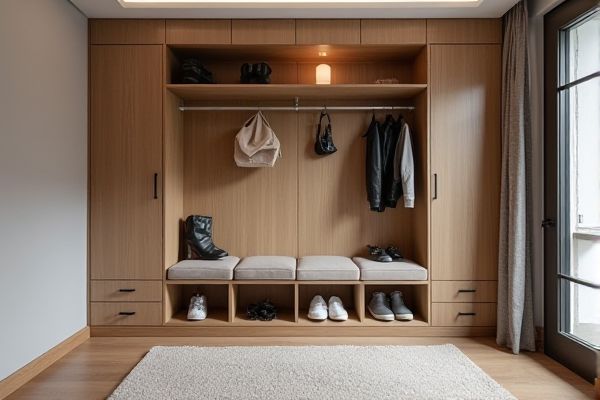
A shoe cabinet offers ample enclosed storage to keep your footwear organized and dust-free, while a shoe bench combines storage with seating, providing a practical spot to put on or take off shoes comfortably. Discover which option best fits your space and lifestyle by exploring the detailed comparison in the rest of this article.
Table of Comparison
| Feature | Shoe Cabinet | Shoe Bench |
|---|---|---|
| Primary Function | Storage for multiple shoes, organized and hidden | Storage + Seating area |
| Storage Capacity | Higher capacity, multiple shelves or compartments | Moderate capacity, usually fewer shoes |
| Design | Vertical, door or drawer-based | Horizontal, cushion topped for sitting |
| Space Usage | Optimizes vertical space, less floor footprint | Requires more floor space, dual-purpose |
| Placement | Entryway, hallway, or closet | Entryway, mudroom, or bedroom |
| User Benefit | Maximized shoe organization and concealment | Convenient seating to wear/remove shoes plus storage |
| Material Options | Wood, metal, MDF, plastic | Wood, upholstered wood, metal frame with cushion |
| Price Range | Generally affordable to mid-range | Mid-range to higher due to seating feature |
Introduction to Shoe Storage Solutions
Shoe cabinets offer compact, upright storage that maximizes vertical space while keeping your footwear neatly organized and out of sight. Shoe benches combine seating with storage, providing a practical spot to sit and easily access your shoes, ideal for entryways or bedrooms. Your choice depends on available space and whether you prioritize hidden storage or functional seating in your shoe storage solutions.
What is a Shoe Cabinet?
A shoe cabinet is a functional furniture piece designed to store and organize multiple pairs of shoes, often featuring enclosed compartments or drawers to keep footwear neatly hidden and protected from dust. It maximizes space efficiency in entryways or closets by providing vertical storage while maintaining a clean, uncluttered appearance. Shoe cabinets typically come in a variety of sizes and styles, offering practical solutions for household shoe storage needs.
What is a Shoe Bench?
A shoe bench combines storage functionality with seating, featuring compartments or shelves to neatly organize shoes while providing a comfortable place to sit during shoe changes. Unlike a traditional shoe cabinet that primarily focuses on enclosed storage, a shoe bench often includes cushioned tops and open or cubby-style storage for quick access to your footwear. Your entryway or mudroom can benefit from a shoe bench by maximizing space efficiency and enhancing comfort.
Design and Aesthetic Differences
Shoe cabinets typically feature tall, enclosed designs with multiple shelves that conceal footwear, offering a sleek and minimalist aesthetic ideal for maintaining a clean entryway. In contrast, shoe benches combine seating with open or partially enclosed storage, emphasizing functionality and a cozy, welcoming look that complements casual or rustic interiors. Your choice depends on whether you prefer a polished, hidden storage solution or a practical piece that doubles as a seating area in your space.
Storage Capacity Comparison
A shoe cabinet offers significantly higher storage capacity with multiple shelves and compartments designed to organize dozens of pairs in a compact footprint. In contrast, a shoe bench provides moderate storage, often limited to a single row or compartment, balancing seating with functionality. Your space requirements and organization needs will determine the ideal choice between ample storage or combined seating convenience.
Space Efficiency: Which Saves More Room?
A shoe cabinet typically saves more room than a shoe bench by utilizing vertical space with multiple shelves behind closed doors, reducing clutter and floor footprint. A shoe bench combines seating and storage but often occupies more horizontal space due to its dual function. Your choice depends on whether maximizing storage capacity or incorporating seating into your entryway is the priority.
Functionality and Multi-Use Features
A shoe cabinet provides ample enclosed storage space, keeping footwear organized and dust-free, ideal for maximizing tidiness in entryways. A shoe bench combines storage with seating, offering multifunctional use by doubling as a convenient spot for putting on shoes while storing multiple pairs underneath. Both options enhance entryway functionality, but the shoe bench introduces added comfort and practical versatility through its integrated seating feature.
Material and Durability Considerations
Shoe cabinets typically feature solid wood, MDF, or metal construction, offering robust durability and ample storage space, while shoe benches often combine wooden or upholstered seats with sturdy frames designed to support weight and provide comfort. Your choice should factor in the material's resistance to moisture, scratches, and daily wear, as high-density wood and powder-coated metal ensure longevity. Consider whether you need a durable storage solution or a functional seating area, as materials vary in resilience and maintenance requirements based on usage.
Price Range and Value for Money
Shoe cabinets typically range from $100 to $400 depending on materials and storage capacity, offering ample organization and protection for footwear, which maximizes value for those prioritizing space efficiency. Shoe benches, priced between $80 and $250, combine seating with storage, providing multifunctional use that enhances value for smaller entryways or compact living areas. Choosing between the two depends on budget flexibility and whether the priority is dedicated storage or added seating functionality.
Choosing the Right Shoe Organizer for Your Home
Choosing the right shoe organizer depends on your available space and storage needs. A shoe cabinet offers enclosed storage with multiple shelves, protecting shoes from dust and providing a tidy appearance. A shoe bench combines storage with seating, making it ideal for entryways where you can comfortably put on or take off your shoes while keeping them organized.
 homyna.com
homyna.com